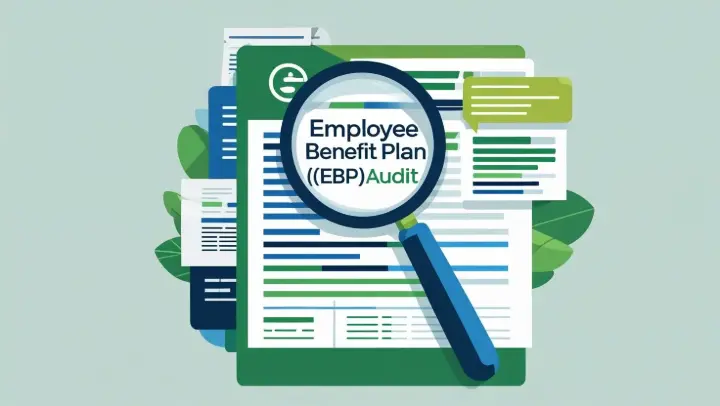Introduction
As your company grows, so does the complexity of managing employee benefit plans like 401(k), 403(b), or defined benefit programs. If your plan reaches 100 eligible participants at the beginning of the plan year, you’re likely required to undergo an Employee Benefit Plan (EBP) audit under the guidelines of the Department of Labor (DOL) and the IRS. But what does that really mean, and how should you prepare?
Whether you’re an HR professional, a controller, or a CPA supporting your clients—understanding the EBP audit process is key to compliance and avoiding unnecessary stress.
In this blog, we’ll walk you through: - When an EBP audit is required - Key players involved - What documents are needed - The audit timeline - Common pitfalls - How outsourcing EBP audit support can simplify your process

1. When Is an EBP Audit Required?
Generally, an audit is required when a qualified retirement plan has 100 or more eligible participants at the start of the plan year. This includes active employees, terminated employees with account balances, and deceased employees with beneficiaries.
This is known as the 80-120 Participant Rule: - If your plan had between 80 to 120 eligible participants in the previous year and was not subject to an audit, you may qualify to defer the audit until the next year. - If you cross the 120-participant threshold, you must conduct an audit.
Plans subject to audit include: - 401(k) plans - 403(b) plans - Profit-sharing plans - Defined benefit pension plans - ESOPs (Employee Stock Ownership Plans)
2. Why Is the EBP Audit Important?
EBP audits serve two primary purposes: 1. Protect Plan Participants – Ensuring contributions, loans, and benefit payments are processed correctly. 2. Regulatory Compliance – Meeting IRS and DOL filing requirements, particularly for Form 5500.
A clean audit also reflects well on your internal controls and can reassure current and potential employees of the plan’s integrity.
3. Who Conducts the EBP Audit?
Only a licensed independent qualified public accountant (IQPA) can perform an EBP audit. The auditor should have experience with: - ERISA (Employee Retirement Income Security Act) regulations - DOL audit guidance - Form 5500 and associated schedules
Some companies use their external auditors for EBP audits, but it’s common to engage a specialized EBP audit team or outsource parts of the audit preparation process.
4. What Documents Are Needed?
Your auditor will request a variety of documents, including:
· Plan Document and Amendments
· Summary Plan Description (SPD)
· Third-Party Administrator (TPA) Reports
· Trust and Custodial Statements
· Participant Census Data
· Payroll Records
· Contribution Remittance Schedules
· Loan & Hardship Withdrawal Documentation
· Investment Reports
Organizing these documents early improves efficiency and reduces back-and-forth.
5. Audit Timeline: When to Start
The best time to start preparing is immediately after the plan year ends. Most companies aim to complete their EBP audits before the July 31 Form 5500 filing deadline.
The typical timeline looks like this: - January–March: Internal reconciliation, data cleanup, document collection - April–June: Audit fieldwork by external auditor - July: Final review and sign-off
Extensions may be filed (until October 15), but the sooner the process starts, the better.
6. Common Challenges & Pitfalls
Many first-time EBP audits experience delays due to:
· Incomplete or inaccurate participant census data
· Late or inconsistent contribution remittances
· Unclear loan documentation
· Failure to apply eligibility rules properly
· Misalignment between payroll and plan data
These issues can lead to audit findings or DOL scrutiny if not addressed proactively.
7. How Outsourced EBP Audit Support Can Help
For CPA firms and plan sponsors, preparing for an EBP audit can be time-consuming. That’s where specialized audit support teams like Trusty Accounts come in:
· Census Data Testing: Verifying eligibility, deferrals, and matches
· Loan & Distribution Testing: Ensuring proper approvals and compliance
· Contribution Reconciliation: Matching payroll to plan records
· Document Compilation: Creating audit-ready packages
Outsourcing improves speed, reduces errors, and lets internal teams focus on strategic goals.
8. Key Takeaways
· If your plan crosses 100 eligible participants, you’re likely subject to a mandatory audit.
· The process involves gathering extensive documentation and aligning payroll with plan data.
· Starting early and maintaining clean records reduces stress and audit risk.
· Consider partnering with a firm like Trusty Accounts to simplify the process and ensure accuracy.
Need Help With Your First EBP Audit?
To stay compliant with ERISA guidelines and Department of Labor (DOL) regulations, growing businesses and CPA firms must understand the complexities of an Employee Benefit Plan audit. Whether you're managing a 401(k), profit-sharing, or defined benefit plan, identifying when an EBP audit is required is critical to avoiding penalties and ensuring transparency. Trusty Accounts offers dedicated Employee Benefit Plan audit services tailored for small and mid-sized businesses, helping them meet Form 5500 audit compliance with confidence. Our team provides outsourced EBP audit preparation and EBP audit support for CPA firms, ensuring every detail aligns with DOL EBP audit checklists. From verifying participant data to managing third-party support for EBP audits, we simplify the process using automation and documentation best practices. If you’re unsure whether your plan crosses the audit threshold, our experts guide you through 401(k) audit requirements, test eligibility, and reconcile contributions—making us a trusted partner in the ERISA EBP audit process. Let us help you reduce risk and ensure readiness with our defined benefit plan audit experts and real-time reporting tools.
From participant-level testing to audit-ready schedules, we make sure your audit gets done right—on time, every time.
📩 Reach out today to get your first 30 days free.